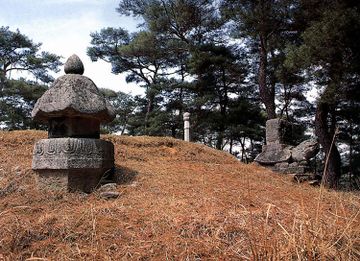"사천 단종 태실지"의 두 판 사이의 차이
(새 문서: {{진행중}} {{문화유산정보 |사진=단종태실지.jpg |사진출처=[http://www.heritage.go.kr/heri/cul/culSelectDetail.do?ccbaCpno=2333800310000 사천 단종 태실지],...) |
|||
| 36번째 줄: | 36번째 줄: | ||
===영문=== | ===영문=== | ||
| + | '''Placenta Chamber Site of King Danjong, Sacheon''' | ||
| + | This is the site of the placenta chamber of King Danjong (r.1452-1455). | ||
| + | |||
| + | A placenta chamber is a special place where a jar housing a royal baby’s placenta and umbilical cord was enshrined. During the Joseon dynasty (1392-1910), the placenta and umbilical cord of a newborn baby were regarded as the origin of life. Thus preserving them would ensure a healthy, advantageous life for the child [영문해설에 없지만 설명을 위해 추가했습니다]. This practice was of particular importance for the royal family, who would enshrine the placenta and umbilical cord of a newborn baby in a place known to be very auspicious. The date of burial also had to be selected to be auspicious. | ||
| + | |||
| + | King Danjong, ascended the throne at a young age, was usurped by his uncle and sent exile to Yeongwol in Gangwaondo Province and died there. | ||
| + | |||
| + | During the Japanese colonial period (1910-1945), the Japanese intentionally destroyed the royal placenta chambers of the Joseon dynasty wishing the downfall of the lineage. In 1929, King Danjong’s placenta jar was relocated and the site was sold to an individual. | ||
| + | |||
| + | Currently on this site, only the stele erected in 1734 and some parts of the chamber remains. | ||
===영문 해설 내용=== | ===영문 해설 내용=== | ||
2019년 9월 29일 (일) 20:24 판
| 사천 단종 태실지 Placenta Chamber Site of King Danjong, Sacheon |
|
 사천 단종 태실지, 국가문화유산포털, 문화재청. |
|
| 대표명칭 | 사천 단종 태실지 |
|---|---|
| 영문명칭 | Placenta Chamber Site of King Danjong, Sacheon |
| 한자 | 泗川 端宗 胎室地 |
| 주소 | 경상남도 사천시 곤명면 은사리 산438번지 |
| 지정번호 | 시도기념물 제31호 |
| 지정일 | 1975년 2월 12일 |
| 분류 | 유적건조물/인물사건/인물기념/탄생지 |
| 시대 | 조선시대 |
| 수량/면적 | 297㎡ |
| 웹사이트 | 사천 단종 태실지, 국가문화유산포털, 문화재청. |
|
|
|
해설문
국문
사천 단종 태실지는 단종(1452~1455 재위)의 태*를 봉안하는 태실**이 있던 곳이다. 이 태실이 언제 조성되었다는 기록은 발견되지 않는다. 숙종 24년(1698)에 단종으로 복권되었기 때문에 그 이후에 왕의 태실로 만들어졌을 것이라고 전해지고 있다.
‘세종대왕단종대왕태실수개의궤’***에는 영조 10년(1734)에 세종대왕 태실 비석과 단종 태실 비석을 같이 세웠다는 기록이 있다.
일제강점기인 1929년에 일본은 조선왕조의 정기를 끊으려고 모든 왕의 태실을 부수고 태실에 봉안된 태 항아리를 경기도 양주로 옮기고 태실이 있던 땅을 개인에게 팔았다. 이때 단종 태실의 땅도 개인에게 팔렸다.
지금은 이곳에 개인의 무덤이 자리하고 있다. 다만 주변에 흩어진 비석과 석조물로 이곳이 단종 태실지였다는 것을 알 수 있을 뿐이다.
- 태(胎): 태반이나 탯줄과 같이 태아를 둘러싸고 있는 여러 조직을 가리키는 말
- 태실(胎室): 왕실에서 왕, 왕비, 대군, 왕세자, 왕자, 왕세손, 왕손, 공주, 옹주 등이 출산하면 그 태를 모시던 곳
영문
Placenta Chamber Site of King Danjong, Sacheon
This is the site of the placenta chamber of King Danjong (r.1452-1455).
A placenta chamber is a special place where a jar housing a royal baby’s placenta and umbilical cord was enshrined. During the Joseon dynasty (1392-1910), the placenta and umbilical cord of a newborn baby were regarded as the origin of life. Thus preserving them would ensure a healthy, advantageous life for the child [영문해설에 없지만 설명을 위해 추가했습니다]. This practice was of particular importance for the royal family, who would enshrine the placenta and umbilical cord of a newborn baby in a place known to be very auspicious. The date of burial also had to be selected to be auspicious.
King Danjong, ascended the throne at a young age, was usurped by his uncle and sent exile to Yeongwol in Gangwaondo Province and died there.
During the Japanese colonial period (1910-1945), the Japanese intentionally destroyed the royal placenta chambers of the Joseon dynasty wishing the downfall of the lineage. In 1929, King Danjong’s placenta jar was relocated and the site was sold to an individual.
Currently on this site, only the stele erected in 1734 and some parts of the chamber remains.
영문 해설 내용
이곳은 조선 제6대 왕인 단종(재위 1452-1455)의 태를 봉안한 태실이 있던 곳이다.
태실은 조선시대 왕실에서 자녀의 태(胎)를 봉안하기 위해 조성한 석실이다. 태는 생명의 근원으로 여겨졌기 때문에, 태아가 출산된 이후에도 함부로 버리지 않고 소중하게 보관하였다. 특히 조선 왕실에서는 왕자나 공주가 태어나면 명당을 물색하고 길일을 가려 태를 봉안하였다.
어린 나이에 왕이 된 단종은 숙부(세조)에게 왕위를 빼앗기고 강원도 영월로 유배되었다가 죽음을 맞이했다. 단종의 태실이 언제 조성되었는지는 정확히 알려지지 않았으나, 1698년에 복권되었기 때문에 그 이후에 조성되었을 것으로 추정된다. 1734년에는 ‘단종대왕 태실’이라고 새긴 비석을 세웠다.
일제강점기인 1929년에 일본은 조선왕조의 정기를 끊을 목적으로 조선 왕조의 태실들을 훼손하였다. 이때 단종의 태실이 있던 땅은 개인에게 팔렸다.
현재 이곳에는 개인의 무덤이 자리하고 있으며, 1734년에 세운 비석과 태실 석재 일부만이 남아 있다.